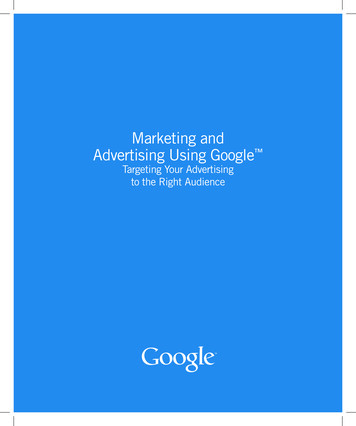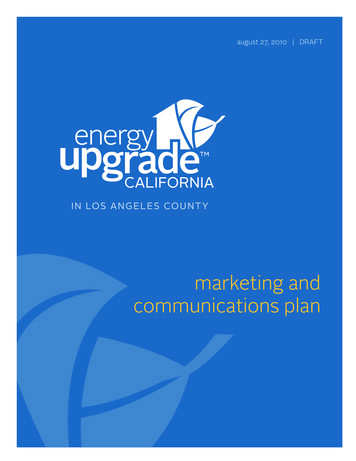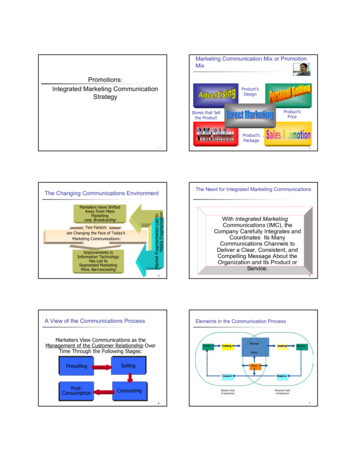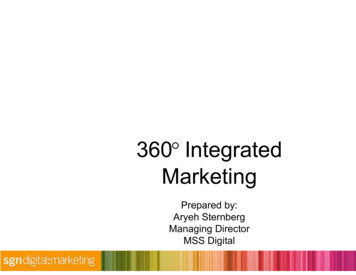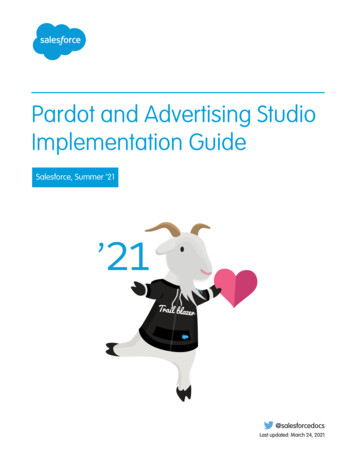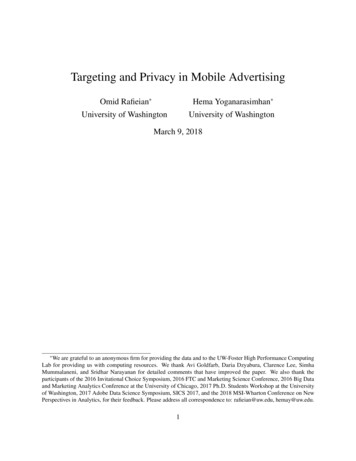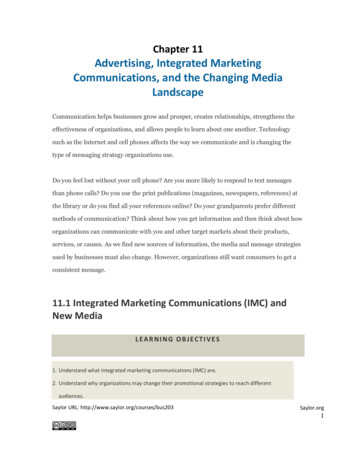
Transcription
Chapter 11Advertising, Integrated MarketingCommunications, and the Changing MediaLandscapeCommunication helps businesses grow and prosper, creates relationships, strengthens theeffectiveness of organizations, and allows people to learn about one another. Technologysuch as the Internet and cell phones affects the way we communicate and is changing thetype of messaging strategy organizations use.Do you feel lost without your cell phone? Are you more likely to respond to text messagesthan phone calls? Do you use the print publications (magazines, newspapers, references) atthe library or do you find all your references online? Do your grandparents prefer differentmethods of communication? Think about how you get information and then think about howorganizations can communicate with you and other target markets about their products,services, or causes. As we find new sources of information, the media and message strategiesused by businesses must also change. However, organizations still want consumers to get aconsistent message.11.1 Integrated Marketing Communications (IMC) andNew MediaLEARNING OBJECTIVES1. Understand what integrated marketing communications (IMC) are.2. Understand why organizations may change their promotional strategies to reach differentaudiences.Saylor URL: http://www.saylor.org/courses/bus203Saylor.org1
Once they have developed products and services, organizations must communicate the valueand benefits of the offerings to both current and potential customers in both business-tobusiness and business-to-consumermarkets. Integrated marketing communications (IMC) provide an approach designed todeliver one consistent message to buyers across an organization’s promotions that may spanall different types of media—TV, radio, magazines, the Internet, mobile phones, and so forth.For example, Campbell’s Soup Company typically includes the “Mm, mm good” slogan in theprint ads it places in newspapers and magazines, in ads on the Internet, and in commercialson television and radio. A company’s ads should communicate a consistent message even if itis trying to reach different audiences. For example, although the messages are very similar,Campbell’s uses two variations of commercials designed to target different consumers. Watchthe two YouTube videos below. You’ll notice that the message Campbell’s gets across isconsistent. But can you figure out who the two target audiences consist of?Changes in communication technology and instant access to information through tools suchas the Internet explain one of the reasons why integrated marketing communications havebecome so important. Delivering consistent information about a brand or an organizationhelps establish the brand in the minds of consumers and potential customers. Manyconsumers and business professionals seek information and connect with other people andbusinesses from their computers and phones. The work and social environments arechanging, with more people having virtual offices and texting on their cell phones orcommunicating through social media such as Facebook. Text messaging, Internet, cellphones, blogs—the way we communicate continues to change the way companies are doingbusiness and reaching their customers. As a result, organizations have realized they need tochange their promotional strategies as well to reach specific audiences.Saylor URL: http://www.saylor.org/courses/bus203Saylor.org2
Many college students are part of the millennial generation, and it is consumers from thisgeneration (people like you perhaps) who are driving the change toward new communicationtechnologies. As we discussed in Chapter 5 "Market Segmenting, Targeting, and Positioning" youmight opt to get promotions via mobile marketing—say, from stores on your cell phone as youwalk by them or via a mobile gaming device that allows you to connect to the Web. Likewise,advertisements on Facebook are becoming more popular as businesses explore social media. Forexample, when Honda let people on Facebook use the Honda logo to give heart-shaped virtualgifts on Valentine’s Day, over one and a half million people participated in the event and viewedthe Honda Fit online in the process. Imagine the brand awareness generated for the Honda Fit.Traditional media (magazines, newspapers, television) now compete with media such as theInternet, texting, and mobile phones; user-generated content such as blogs and YouTube;and out-of-home advertising such as billboards and movable promotions. You might havenoticed that the tray tables on airplanes sometimes have ads on them. You have probably alsoseen ads on the inside of subway cars, in trains and buses, and even in bathroom stalls. These,too, are examples of out-of-home advertising.As the media landscape changes, the money organizations spend on different types ofcommunication will change as well. Some forecasts indicate that in the next five years companieswill increase their expenditures on new media from approximately 16 percent of their totalpromotional budgets to almost 27 percent of their budgets, or 160 billion by 2012.[1]KEY TAKEAWAYAs the media landscape changes, marketers may change the type of promotions they use in order toreach their target markets. With changing technology and social media (e.g., Facebook), less money isbeing budgeted for traditional media such as magazines and more money is budgeted for “newSaylor URL: http://www.saylor.org/courses/bus203Saylor.org3
media.” Regardless of the type of media used, marketers use integrated marketing communications(IMC) to deliver one consistent message to buyers.REVIEW QUESTIONS1. Explain the concept of integrated marketing communications.2. How is the media used by organizations changing? What age group is driving the change?3. What factors are causing the media landscape to change?[1] “PQ Media: New Media Spend to Hit 160B in 2012,” MarketingVOX, March edia-spend-to-hit-160b-in-2012-037592 (accessedDecember 15, 2009).11.2 The Promotion (Communication) MixLEARNING OBJECTIVES1. Understand the different components of the promotion mix.2. Understand the different types of media and vehicles.Although the money organizations spend promoting their offerings may go to different mediachannels, a company still wants to send its customers and potential consumers a consistentSaylor URL: http://www.saylor.org/courses/bus203Saylor.org4
message (IMC). The different types of marketing communications an organization usescompose its promotion or communication mix, which consists of advertising, salespromotions, public relations and publicity, personal selling, and direct marketing.Advertising involves paying to disseminate a message that identifies a brand (product orservice) or an organization being promoted to many people at one time. The typical mediathat organizations utilize for advertising of course include television, magazines, newspapers,the Internet, direct mail, and radio. As we explained, businesses are also advertising on socialmedia such as Facebook, blogs, Twitter, and mobile devices. Each medium (television ormagazines or mobile phones) has different advantages and disadvantages. A few examples ofadvantages and disadvantages are discussed below.For example, mobile phones provide continuous access to people on the go althoughreception may vary in different markets. Radios, magazines, and newspapers are alsoportable. People tend to own more than one radio, but there are so many radio stations ineach market that it may be difficult to reach all target customers. People typically are doinganother activity (e.g., driving or studying) while listening to the radio, and without visuals,radio relies solely on audio. Both television and radio must get a message to consumersquickly. Although many people change channels or leave the room during commercials,television does allow for demonstrations. In an effort to get attention, advertisers havechanged the volume for television commercials for years. However, the Federal TradeCommission passed a new regulation effective in 2010 that prohibits advertisers fromchanging the volume level of commercials on television.People may save magazines for a long time, but advertisers must plan in advance to have adsin certain issues. With the Internet, both magazines and newspapers are suffering in terms ofreadership and advertising dollars. Many major newspapers, such as papers in Seattle andChicago, have gone out of business. Local news and the fact that local retailers get cheaperSaylor URL: http://www.saylor.org/courses/bus203Saylor.org5
rates for advertising in local newspapers may encourage both local businesses andconsumers to support newspapers in some markets.Figure 11.4The first issue of Sports Illustrated was published August 16, 1954. Today, the companies that advertisein Sports Illustrated do so not only in the magazine but also on the Web site.Source: Wikipedia.One of the biggest factors an organization must determine is which medium or mediaprovides the biggest bang for the buck, given a product’s characteristics and target market.For example, a thirty-second ad aired during Super Bowl XLII cost 2.7 million. However, arecord number of 97.5 million people watched the game, so the cost per ad was less thanthree cents per viewer. But do the ads pay off for companies in terms of sales? Manyadvertising professionals believe many of the ads don’t. However, the ads probably do have abrand awareness or public relations type of effect.Saylor URL: http://www.saylor.org/courses/bus203Saylor.org6
Within each different medium, an organization might select a different vehicle. A vehicle isthe specific means within a medium to reach a selected target market. For example, if acompany wants to develop commercials on television to reach teenagers, it mightselect Gossip Girl on the CW as the best vehicle. If an organization wants to use magazines toreach males interested in sports, it might use Sports Illustrated. As technologychanged, Sports Illustrated launched SI.com so readers could get up-to-date information onthe Web. On SI.com, readers can also access links to popular articles and om/vault), where they can search articles and picturesthat have run in the magazine since it was launched in 1954.Personal selling is an interactive, paid approach to marketing that involves a buyer and aseller. The interaction between the two parties can occur in person, by telephone, or viaanother technology. Whatever medium is used, developing a relationship with the buyer isusually something the seller desires.When you interview for internships or full-time positions and try to convince potentialemployers to hire you, you are engaging in personal selling. The interview is very similar to abuyer-seller situation. Both the buyer and seller have objectives they hope to achieve.Although business-to-business markets utilize more personal selling, some business-toconsumer markets do as well. If you have ever attended a Pampered Chef or Tupperwareparty or purchased something from an Amway or Mary Kay representative, you’ve beenexposed to personal selling. Chapter 13 "Professional Selling" discusses personal selling inmore detail and when it should and should not be used.Public relations (PR) helps improve and promote an organization’s image and products byputting a positive spin on news stories. Public relations materials include press releases,publicity, product placement, and sponsorships. Companies also use PR to promote productsand to supplement their sales efforts. PR is often perceived as more neutral and objectiveSaylor URL: http://www.saylor.org/courses/bus203Saylor.org7
than other forms of promotion because much of the information is tailored to sound as if ithas been created by an organization independent of the seller. Many companies have internalPR departments or hire PR firms to find and create public relations opportunities for them.As such, PR is part of a company’s promotion budget. In Chapter 12 "Public Relations andSales Promotions" we’ll discuss the specific PR tools companies use as part of their integratedmarketing communications.Sales promotions consist of other types of promotions—coupons, contests, games, rebates,mail-in offers, and so forth—that are not included as part of another component of thecommunication mix. Sales promotions are often developed to get customers and potentialcustomers to take action quickly, make larger purchases, and make repeat purchases. Manystores now place coupons next to products to encourage consumers to select a particularbrand and products.In business-to-business marketing, sales promotions are typically calledtrade promotions because they are targeted to channel members who conduct business ortrade with consumers. Trade promotions include trade shows, sponsorships, eventmarketing, and special incentives given to retailers, such as extra money, in-store displays,and prizes to market particular products and services. Sales promotions are often used tosupplement advertising and create incentives for customers to buy products morequickly. Chapter 12 "Public Relations and Sales Promotions" also discusses the differenttypes of sales promotion tools companies have available.Direct marketing involves delivering personalized promotional materials directly toindividual consumers. It provides an interactive approach for organizations to reachconsumers in hopes of getting consumers to take action. Materials may be delivered via mail,catalogs, Internet, e-mail, telephone, or direct-response advertising. Several benefits of directmarketing include the ability to target a specific set of customers, measure the return onSaylor URL: http://www.saylor.org/courses/bus203Saylor.org8
investment (ROI), and test different strategies before implementing to all targetedconsumers. However, direct marketing is very intrusive and many consu
Advertising, Integrated Marketing Communications, and the Changing Media Landscape Communication helps businesses grow and prosper, creates relationships, strengthens the effectiveness of organizations, and allows people to learn about one another. Technology such as the Internet and cell phones affects the way we communicate and is changing the
